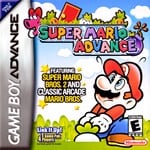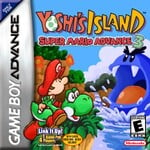Super Mario Advance (series): Difference between revisions
m (Removing link that redirects back to this page.) |
Koopa lover (talk | contribs) (→''Super Mario Advance 4: Super Mario Bros. 3'': Name a few differences from home console SMB3) |
||
| Line 60: | Line 60: | ||
This game's largest added feature was compatibility with the [[e-Reader]] and [[Super Mario Advance 4 e-Cards|e-Cards]]. These cards could be scanned in to the game, and would function as new levels, instant power-ups, or demos. One power-up card features a power-up that cannot be found in any other Mario game: the [[Boomerang]]. | This game's largest added feature was compatibility with the [[e-Reader]] and [[Super Mario Advance 4 e-Cards|e-Cards]]. These cards could be scanned in to the game, and would function as new levels, instant power-ups, or demos. One power-up card features a power-up that cannot be found in any other Mario game: the [[Boomerang]]. | ||
Some changes were: | |||
*[[Spade Panel]]s now produce different variants in response to completing one. | |||
*Mario can have more than 100 lives. | |||
*Getting a [[Fire Flower]] or [[Raccoon Leaf]] will make Mario their usual power, even if he gets hit to become small Mario before touching it. | |||
*[[Koopa Troopa]]s can now be stomped underwater. | |||
*Giant [[Brick block]]s can now be broken with Mario's tail. | |||
*In several levels of [[Giant Land|World 4]], just before the Goal Panel, there is a coin bonus in the sky. | |||
*In [[Sky Land|World 5]], some brick blocks that otherwise make Pipes and Bullet Bill cannons float in the air contain coins. | |||
*In [[Ice Land|World 6]], the path to the Mushroom House was altered so you don't have to do 6-5 to access it. | |||
[[Category: Game Series]] | [[Category: Game Series]] | ||
[[Category: Platforming Games]] | [[Category: Platforming Games]] | ||
[[Category: Remakes]] | [[Category: Remakes]] | ||
Revision as of 10:07, May 8, 2008
The Super Mario Advance series is a group of four games for the Game Boy Advance. Each game contains one of the classic Mario sidescrollers, with improved graphics, sound, and additional features. Also, each game contains an updated version of the NES game Mario Bros.
Multi-Player mode
A game from the Super Mario Advance series can link up to other Game Boy Advances. This allows two people to play a version of the two-player Mario Bros, with better graphics, control, and sound.
Also, up to four GBAs can link up to each other and play a special, 4-player version of Mario Bros. The object in this version is to collect coins. Coins appear when an enemy is defeated. Whoever gets five coins first, wins. The most notable added feature is the trash can. Players can pick up and throw each other, and players can be thrown in the trash can. A player in the trash can is stuck there for several seconds, putting them at a disadvantage, but will come out with an item that helps them fight the other players.
Super Mario Advance
Super Mario Advance features the classic game Super Mario Bros. 2, although in the game it is referred to as Super Mario 2. Some changes from the original are the following:
- The graphics resemble the Super Mario All-Stars version of the game.
- Voices for Mario, Luigi, Princess Peach, Toad, and the bosses were added.
- The game can be saved after every level.
- A circular character select screen is shown, instead of Mario, Luigi, Peach, and Toad having to line up in a row.
- A point system has been added. Players get more points for making one thrown object hit lots of enemies. If enough enemies are hit, an extra life will be awarded.
- Hearts appear much more frequently than in the original. Whenever three or more vegetables or enemies are involved in a collision, a heart appears. Also, hearts can be pulled out of the ground.
- Giant Vegetables have been added to the game. These voluminous vegetables take a long time to pull out of the ground, but function normally otherwise (apart from having a larger area to hit enemies with).
- Giant Shy Guys and Giant Ninjis have also been added. These Shy Guys take a long time to pick up, and whenever they are thrown or involved in a collision, they yield a heart.
- Giant POW Blocks have also been added. These bounce several times, each time having the effect of a normal block.
- Shells were made larger, and they now bounce off walls and yield hearts whenever they collide with enemies.They also now take longer to pick up, and appeared in a little more levels.
- The insides of vases were changed.
- Starting the level, the player starts out with only one heart filled in the heart meter.
- An extra mushroom was added per level.
- In each level, there are five red Ace Coins. If all are collected, the player receives an extra life, and the level gets a star on it on the map screen.
- When the game is finished, a new "Yoshi's Challenge" mode appears. Now, there are two eggs hidden in Subspace in each level, and the player must find and collect them all.
- Robirdo replaces Mouser as the boss of World 3.
- More enemies were added in the game.
- Some things in the game, such as the Subcons, were completely changed in art.
- The Phanto enemies now made noises when they moved around the screen, and would also move forwards into the screen, making them look like they were gigantic.
Nintendo's decision to choose this title as a Game Boy Advance launch game was seen by some as misguided; GameSpot in particular thought that Super Mario Bros. 3 or Super Mario World would have been a far better choice for a launch title considering their popularity. (Both of these titles would eventually be remade as a part of the SMA series, however.) However, IGN praised the choice, calling it "one of the most polished and creative platformers of the era." Nonetheless, it was a best-selling launch game, showing that the game still appealed to Nintendo fans. Recently, the game has become a part of the Player's Choice lineup for the Game Boy Advance as one of the system's first three player's-choice games (along with Mario & Luigi: Superstar Saga and Super Mario Advance 3.) It was the first Mario game for the Game Boy Advance, released in 2001.
Super Mario World: Super Mario Advance 2
As the name suggests, this game features Super Mario World. It was the second video game in the Super Mario Advance series, and was released for the Game Boy Advance in 2001. Some changes from the original SNES version are;
- If the player manages to collect all 5 Yoshi Coins in every single level, all the Yoshi Coins will change into Peach Coins (after watching a cutscene where this happens). The player can also check out in which levels the Yoshi Coins have been collected or not, by simply pressing SELECT.
- Voices have been added to Mario, Luigi and all of the Bosses apart from the Reznors. Some of Mario and Luigi's voices were ripped from the first Mario Advance, while the others are new. Also, bosses yelp as Bowser does today when they are defeated.
- Players can have up to 999 lives and save the number of lives for the next time the player plays the game.
- There are more Message Blocks throughout the game than the SNES version. They're now also headed with the phrase "Tourist Tips" on top of each one the player gets.
- When the player gets hurt with Cape or Fire power, the player won't become tiny and need to use the item in reserve(if any), but the player will become Super Mario/Luigi, and they will keep the reserve item.
- The player can get the colored Yoshis in any Yoshi Block, Blue if the player is with the cape, Red with the Fire Flower, and random when tiny or Super(but this only happens if the player already freed them from the eggs on Star Road).
- Luigi is an optional character for player 1 and he has some differences like: jumps better, runs a bit slower, and his Yoshi waits a bit to swallow an enemy (being able to spit it back out at an enemy), other then Mario's, that swallows it instantly (except for shells).
- The player can also save half-way through a level once the player has past the half-way gate and quit. When the player comes back to that level, the player will start from the half-way gate, and it is not affected by playing another level after doing this process.
- The rescued Yoshi Egg dots are colored instead of being a dull gray-brown color.
- Luigi is updated to resemble his current look: tall and skinny, while Mario and all the others are still the original sprites from the SNES game.
Yoshi's Island: Super Mario Advance 3
Yoshi's Island: Super Mario Advance 3 is a remake of Super Mario World 2: Yoshi's Island for the Game Boy Advance. It is very much like the Super Nintendo version, yet this newer version has much better sprites, levels and voices. Like all the other Super Mario Advance games, It also comes with a remake of Mario Bros.
The original version had 21 red coins in More Monkey Madness (Extra 3), but the remake only has 20. There was a red coin under a Tap-Tap - if the player performs a Ground Pound on the Tap-Tap's pillar, once the player collects it. This has been removed from the remake.
The biggest change was the addition of six extra levels in the remake, called Secret levels. These are to the left of the Extra levels on the map screen, and are unlocked by defeating Baby Bowser on level 6-8.
Super Mario Advance 4: Super Mario Bros. 3
In 2003, the fourth entry in the Super Mario Advance series, Super Mario Advance 4: Super Mario Bros. 3 was released for the Game Boy Advance. It was actually a heavily updated version of Super Mario Bros. 3 as the name suggests. However, it boasted similar graphics and sound to the All-Stars version. It features a save system similar to the Super Mario All-Stars save system, except temporary saves may now be done anywhere.
This game's largest added feature was compatibility with the e-Reader and e-Cards. These cards could be scanned in to the game, and would function as new levels, instant power-ups, or demos. One power-up card features a power-up that cannot be found in any other Mario game: the Boomerang.
Some changes were:
- Spade Panels now produce different variants in response to completing one.
- Mario can have more than 100 lives.
- Getting a Fire Flower or Raccoon Leaf will make Mario their usual power, even if he gets hit to become small Mario before touching it.
- Koopa Troopas can now be stomped underwater.
- Giant Brick blocks can now be broken with Mario's tail.
- In several levels of World 4, just before the Goal Panel, there is a coin bonus in the sky.
- In World 5, some brick blocks that otherwise make Pipes and Bullet Bill cannons float in the air contain coins.
- In World 6, the path to the Mushroom House was altered so you don't have to do 6-5 to access it.

